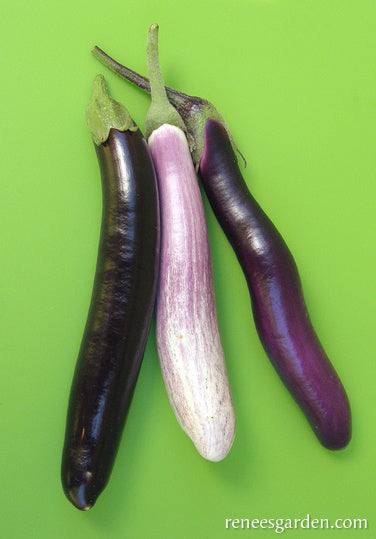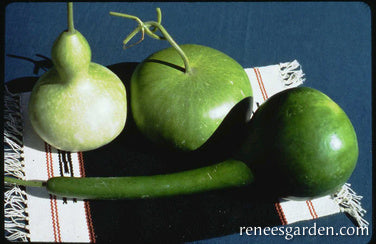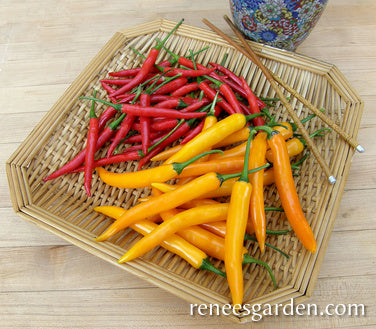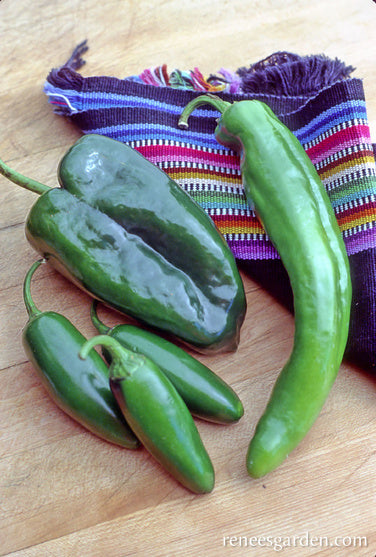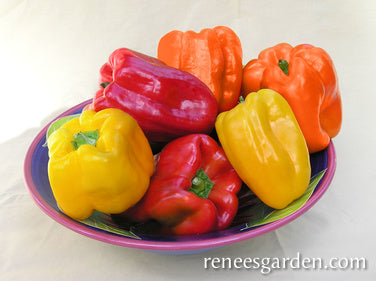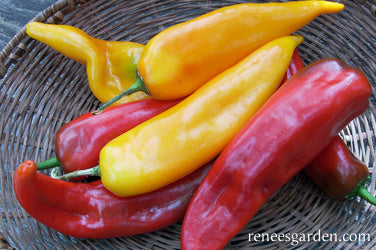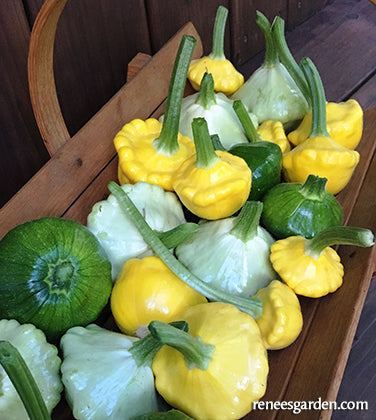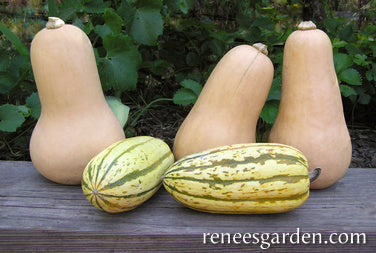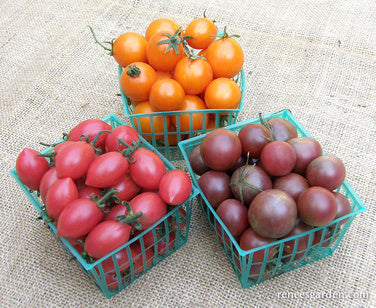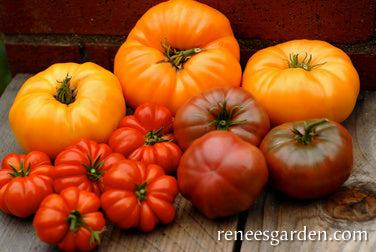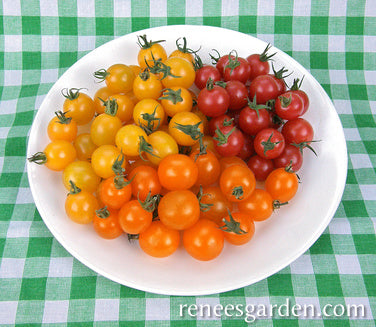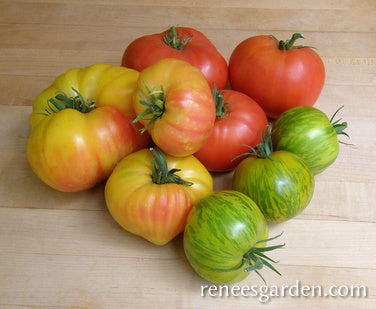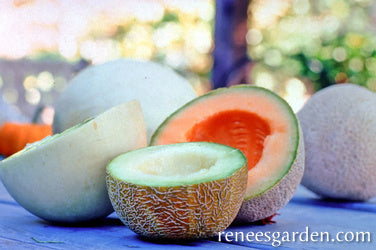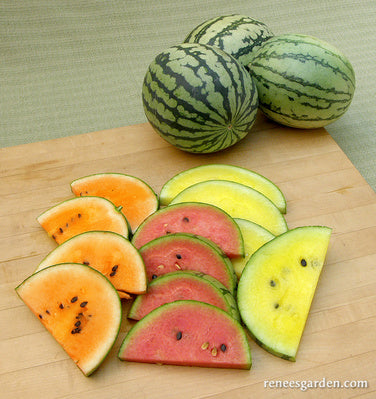Renee's Exclusive 3-In-1 Rainbow Packets
Renee's Exclusive 3-In-1 Rainbow Packets
Our exclusive Rainbow 3-in-1 Vegetable Packets contain different colors or varieties in one packet, each individually tinted with USDA food grade color so you can tell them apart at planting time. You'll have multiple colors and/or varieties from just one economical packet, yielding more flavors, nutritional benefits and eye appeal in both garden and kitchen.
-
Specialty Eggplants Italian Trio
BEST TO START INDOORS
In early spring, start indoors about 2 months before outdoor night temperatures are reliably in the 50 (10°C) range. Sow seeds 1/4 inch deep and 1 inch apart in a container of seed starting mix. Keep moist and warm and provide a strong light source until seedlings are ready to plant outside. When seedlings are 2 inches tall, transplant into deeper individual containers. Maintain at 70 to 75° (21-24°C). Feed with half-strength fertilizer every 2 weeks until weather is warm enough to gradually acclimate seedlings to outdoor conditions. Transplant 2 feet apart into rich soil in full sun.
GROWING NOTES
Don’t transplant these heat-lovers outdoors until night temperatures stay securely above 55° (13°C). Prepare soil well with aged manure or compost. Plant only robust seedlings with well-developed roots and mulch well. Fertilize plants regularly throughout the season.
HARVEST AND USE
Pick when fruits have sized up and are firm fleshed and glossy. Slice 1/2 inch thick, brush with olive oil and broil until tender. Then layer with a rich tomato sauce, fresh herbs and several cheeses to make Eggplant Parmesan. Bake whole in a hot oven, then scoop out flesh and mash with garlic, olive oil, lemon juice and chopped parsley for a savory dip to serve on toasted pita bread.
Regular price $3.69Sale price $3.69Unit price / per -
Specialty Eggplants Asian Trio
BEST TO START INDOORS
In early spring, start indoors about 2 months before outdoor night temperatures are reliably in the 50-55°F (10-13°C) range. Sow seeds 1/4 inch deep and 1 inch apart in a container of seed starting mix. Keep moist and warm 80-85°F (27-30°C) and provide a strong light source until ready to plant outside. When seedlings are 2 inches tall, transplant into deeper individual containers. Maintain at 70-75°F (21-24°C). Feed with half-strength fertilizer every 2 weeks until weather is warm enough to gradually acclimate seedlings to outdoor conditions. Transplant 2 feet apart into rich soil in full sun.
GROWING NOTES
Don’t transplant these heat-lovers outdoors until nights stay securely above 55°F (13°C). Prepare soil well with aged manure or compost. Plant only robust seedlings with well-developed roots and mulch well. Fertilize plants regularly throughout the season.
HARVEST AND USE
Pick when fruits have sized up and are firm fleshed and glossy. Harvest Charming babies at 3 to 6 inches, Asian Bride at 7 to 8 inches, and Farmers Long at 9 to 11 inches, or before fruits get dull and seedy. Slice for great sautés or halve lengthwise, brush with oil and grill with your favorite herbs and cheese or Asian-style seasonings.
Regular price $3.69Sale price $3.69Unit price / per -
Crafter's Gourds Bottles & Bowls
BEST TO START SEEDS INDOORS
Several weeks before last spring frost date, sow seeds 1 inch deep in individual pots of seed starting mix. Keep warm and moist while awaiting germination and provide a strong light source. When seedlings are well-established and night temps. stay above 50°F (10°C), acclimate to outdoor conditions. Transplant at sunny garden edges to ramble, or 12 inches apart along a sturdy fence or trellis to form a lush canopy.
START SEEDS OUTDOORS
Start seeds outdoors only in areas with a very long growing season. Plant after night temps. stay above 50°F (10°C). In full sun, sow 2 or 3 seeds 1 inch deep and in groups spaced 12 inches apart and 4 inches from vertical supports. Thin to 1 or 2 strongest seedlings per group. Or plant 6 to 8 seeds in hills 8 feet apart, thinning to 3 or 4 per hill and allowing vines to ramble.
GROWING NOTES
Gourds need full sun, very rich fertile soil and warm temperatures. For earliest and best yields, hand-pollinate gourds: break off a blooming male flower and dust pollen onto fresh female flowers (the ones with small fruits at the base). Repeat as new flowers appear. Pollinated fruits start growing larger within several days.
HARVEST AND USE
Gourds are mature when the tendril next to stem has turned brown and rinds are tough. Harvest with several inches of stem. Dry gourds in a well-ventilated place. Once fully cured, (which can take several months) gourds are light for their size and seeds will rattle inside. Molds often develop on the surface, but do no harm. Discard gourds that rot or are soft and wrinkled.
Regular price $3.99Sale price $3.99Unit price / per -
True Thai Chiles Full Moon & Vesuvius
STARTING SEEDLINGS
In early spring, start indoors about 2 months before night temperatures stay reliably 50-55°F (10- 13°C). Sow seeds 1/4 inch deep and 1inch apart in a container of seed starting mix. Keep moist but not soggy, and very warm 80-85°F (27-30°C). Provide a strong light source until seedlings are ready to plant outside. When seedlings are 2 inches tall, transplant into deeper individual containers. Maintain at 70-75°F (21-24°C). Feed with half strength fertilizer every week until weather is warm enough to gradually acclimate seedlings to outdoor conditions. Transplant 2 feet apart into rich soil in full sun.
GROWING NOTES
Chiles need warm conditions. Don’t transplant outdoors until night temperatures stay securely above 55°F (13°C). Prepare soil well with aged manure or compost. Plant only robust seedlings with well-developed roots. Mulch plants to maintain even soil moisture. Keep well weeded, watered and fertilized.
HARVEST AND USE
Harvest when chiles have a high gloss and are fully ripened to orange for the medium-hot Full Moon and red for Vesuvius. To dry for year-round use, cut whole branches of chiles or harvest individually and string from the stem end. Hang in a warm, airy location. Use in all Thai and Asian stir-fries, sauces, salsas and marinades or dry and chop for spicy chile flakes to sprinkle on pizza.Regular price $3.99Sale price $3.99Unit price / per -
Chile Peppers Southwestern Chile Trio
STARTING SEEDLINGS
In early spring, start seeds indoors about 2 months before night temps are reliably in the 50-55°F (10-13°C) range. Sow seeds ¼ inch deep and 1 inch apart in seed starting mix. Keep moist but not soggy and very warm, 80-85°F (27-29°C). Provide a strong light source until ready to plant outside. When seedlings are 2 inches tall, transplant into individual small pots. Maintain at 70-75°F (21-24°C). Feed with half-strength fertilizer every 2 weeks until weather is warm enough to gradually acclimate seedlings to outdoor conditions. Transplant 2-2 1/2 feet apart into rich soil in full sun.
GROWING NOTES
Don’t transplant chiles outdoors until night temperatures stay securely above 55° (13°C). Prepare soil well with aged manure or compost. Plant only robust seedlings with well developed roots. Mulch well to maintain even soil moisture. Stake or cage chile plants to support their heavy fruit sets. Keep weeded, watered and feed monthly throughout the growing season.
HARVEST AND USE
Harvest when chiles have a high gloss by cutting, not pulling, them from the plant. Color develops as chiles mature; pick green or allow to color up. Use mild Anchos, medium New Mex, and hot Jalapeños to suit your taste in all kinds of delicious salsas, fajitas, chile rellenos, rich sauces, rubs, soups or stews. Use fresh, or roast and remove skins. Freeze roasted chilies for future use.
Regular price $4.69Sale price $4.69Unit price / perNew -
Mild Habanero Chiles Orange & Red Suave
STARTING SEEDLINGS
In early spring, start indoors about 2 months before night temperatures stay reliably 50 - 55°F (10 - 13°C). Sow seeds 1/4 inch deep and 1 inch apart in a container of seed starting mix. Keep moist but not soggy, and very warm 80°F (27°C). Provide a strong light source until seedlings are ready to plant outside. When seedlings are 2 inches tall, transplant into deeper individual containers. Maintain at 70°F (21°C). Feed with half-strength fertilizer every week until weather is warm and settled, then gradually acclimate seeds to outdoor conditions. Transplant 2 feet apart into rich soil in full sun.
GROWING NOTES
Habaneros need warm conditions. Don’t transplant outdoors until night temperatures stay securely above 55°F (13°C). Prepare soil well with aged manure or compost. Plant only robust seedlings with well-developed roots. Mulch plants to maintain even soil moisture. Keep well weeded, watered and fertilized.
HARVEST AND USE
To harvest, cut rather than pull fruits from the plants when fully colored orange or red. With Suaves, you’ll enjoy habaneros' unique taste without their incendiary heat. Use freely in all kinds of fresh salsas, sauces, jerk rubs and marinades. You’ll find them no hotter than mellow New Mexico green chilies, with Suave Red rated a mild 580 Scoville units and Suave Orange a smooth 835 heat units, compared to the 575,000 heat units of the normal habanero chile!
Regular price $3.39Sale price $3.39Unit price / per -
Jewel-Toned Bell Peppers Crimson, Gold & Orange
STARTING SEEDLINGS
In early spring, start indoors about 2 months before outdoor night temps are reliably in the 50-55°F (10-13°C) range. Sow seeds 1/4 inch deep and 1 inch apart in a container of starting mix. Keep moist but not soggy, and very warm, 80-85°F (27- 29°C). Provide a strong light source until seedlings are ready to plant outside.
When seedlings are 2 inches tall, transplant 2 inches apart into deeper containers or individual pots. Maintain at 70-75°F (21-24°C). Feed with half-strength fertilizer every 2 weeks until weather is warm enough to gradually acclimate seedlings to outdoor conditions. Plant out 2 1/2 feet apart into rich soil in full sun.
GROWING NOTES
Don’t plant peppers outdoors until night temperatures are above 55°F (13°C). Prepare soil with aged manure or compost. Plant only robust seedlings with well-developed roots. Mulch plants to maintain even soil moisture. Stake or cage your plants to help support their heavy fruit set.
HARVEST AND USE
Ready to pick in late summer, pepper fruits start out green and ripen up to rich red, orange or golden yellow, depending upon variety. Edible at any stage, glossy, fully colored fruits have the best flavor and are high in vitamins A and C. Carefully cut rather than pull peppers from plants. Enjoy these pretty peppers sliced up raw, sautéed, stir fried or grilled.Regular price $4.99Sale price $4.99Unit price / per -
Italian Roasting Peppers Corno di Toro Mix
STARTING SEEDLINGS
In early spring, start indoors about 2 months before night temperatures stay above 50-55°F (10-13°C). Sow seeds 1/4 inch deep and 1 inch apart in a container of seed starting mix. Keep moist but not soggy, and very warm 80-85°F (27-29°C). Provide a strong light source until seedlings are ready to plant outside. When 2 inches tall, transplant 3 inches apart into deeper containers. Maintain at 70-75°F (21-24°C). Feed with half strength fertilizer every week until weather is warm enough to gradually acclimate seedlings to outdoor conditions. Transplant 2 feet apart into rich soil in full sun.
GROWING NOTES
Don’t transplant outdoors until nights are above 50°F (10°C). Prepare soil well with aged manure or compost. Plant only robust seedlings with well-developed roots. Mulch plants to maintain even soil moisture.
GROWING & HARVEST
Peppers need full sun at least 6 hours per day. Mulch well to maintain even moisture. Fertilize weekly to establish vigorous plants that provide shade and protect fruit from sunburn. Plants must be staked or caged to keep branches from breaking under their heavy fruit set. Harvest when fruits are glossy and turn from green to fully red or yellow by cutting, not pulling from plants. Eat fresh, roast or grill or try them Italian style, sautéed with tomatoes, olive oil, garlic and basil, accompanied by good hard cheese and crusty bread.
Regular price $3.69Sale price $3.69Unit price / per -
Holiday Mix Pumpkins Autumn Gold & Spookie
BEST TO START OUTDOORS
Pumpkins need full sun, rich fertile soil and warm temperatures. Wait to plant until temperatures stay above 50°F (10°C) day and night. Sow groups of 2 to 3 seeds 3 feet apart and 1 inch deep in rows 4 feet apart. Thin to 1 strong seedling per group to give vines room to spread.
Or, make slightly mounded hills 2 to 3 feet across and 8 ft. apart and plant 4 to 5 seeds of one variety in each hill. When seedlings have several sets of leaves, thin to 3 seedlings per hill. Protect young seedlings from marauding birds by covering with plastic berry baskets at sowing time, removing before young plants get crowded.
HARVEST AND USE
All pumpkins need to mature properly, so wait to pick until rinds are fully colored and tough enough to resist piercing with a fingernail and vines have died back. Then cut, leaving a good stem handle. Let them cure for 10 days in the sun, then store in a cool dry place and they’ll keep for months.
Carve Autumn Gold into happy or scary holiday faces and use Spookie pumpkins for smaller Jack O’Lanterns or bake them up into sweet spicy pie or savory soups.
Regular price $3.99Sale price $3.99Unit price / per -
Tricolor Pattypan Squash Summer Scallop Trio
START SEEDS OUTDOORS
Squash needs full sun, rich fertile soil and warm temperatures. Plant only when spring weather is warm and settled and night temperatures stay above 50°F (10°C). Sow groups of 2 to 3 seeds 1 inch deep and 1 1/2 feet apart in rows 2 feet apart. When several inches long, thin to 1 strong seedling per group. Or, plant in slightly mounded hills, 2 feet in diameter and 2 feet apart. Sow 5 to 6 seeds 1 inch deep and 4 inches apart in each hill. When seedlings are several inches long, thin hill-planted seedlings to the 2 strongest plants so they have ample room to grow.
HARVEST AND USE
Harvest scallops when no more than 2 to 3 inches across for best flavor and tenderness. Frequent harvesting keeps plants producing tasty new squashes instead of maturing large, tough and pithy ones. Steam or stir fry the little pattypans and sprinkle with chopped fresh herbs like chives, basil, finely snipped dill or lemon basil. Cook and toss all 3 jewel-toned squashes with freshly ground pepper, butter and grated Parmesan.
GROWING NOTES
Amend soil well before sowing with lots of aged manure or compost. Protect young seedlings from marauding birds by covering with green plastic berry baskets at planting time, removing when plants get crowded. Be sure to thin properly — you will have more productive, disease-free plants if seedlings have enough room to mature.Regular price $4.39Sale price $4.39Unit price / per -
Winter Squash Duo Early Butternut & Delicata
BEST TO START OUTDOORS
Squash needs full sun, rich, fertile soil and warm temperatures. Plant only when weather is warm and settled and night temperatures stay above 50°F (10°C) both day and night. Make slightly mounded growing hills 2 to 3 feet apart. Plant varieties separately, 1 inch deep, 8 inches apart, 4 seeds per hill. Thin seedlings to leave the 2 strongest plants per hill so vines will have room to grow and mature.
GROWING NOTES
Protect young seedlings from marauding birds by covering with plastic berry baskets at sowing time, removing before plants get crowded.
HARVEST AND USE
Winter squash needs the full growing season to mature properly so it will keep for winter eating. When rinds are tough enough to resist a fingernail, cut fruits from vines with a good stem. Let them cure for 1 week in the sun, then store in a cool dry place. Enjoy Delicata first as they don’t store as long as Early Butternut, which stay in excellent eating condition for several months. Simply cut in half and bake or skin and sauté the sweet flesh to serve with a little butter and a sprinkling of salt or add a pinch of sage or thyme for an herbal accent.
Regular price $4.39Sale price $4.39Unit price / per -
Tricolor Zucchini Jade, Gold & Emerald
START SEEDS OUTDOORS
Zucchinis need full sun, rich fertile soil and warm temperatures. Plant only when spring weather is warm and night temperatures stay above 50°F (10°C). Sow 2 to 3 seeds, 1 inch deep, every 2 feet, in rows 3 feet apart. Thin to leave only 1 seedling every 2 feet. Or, plant in slightly mounded hills, 2 feet in diameter, sowing 5 or 6 seeds in each hill. Thin hill-planted seedlings to 2 or 3 strongest plants.
GROWING NOTES
Amend soil well before sowing with lots of aged manure or compost. Protect young seedlings from marauding birds by covering with plastic berry baskets at planting time, removing when plants get crowded. Be sure to thin properly — you will have more productive, disease-free plants if seedlings have enough room to mature.
HARVEST AND USE
Harvest zucchini when no more than 5 to 6 inches long for best flavor and tenderness. Frequent harvesting keeps plants producing tasty new fruits instead of maturing fat, tough, huge ones. Steam, stirfry or grill sliced zucchinis and sprinkle with fresh parsley, dill, basil or thyme. Try the tasty blossoms sautéed or stuffed and baked. Heap a platter with spears of all 3 colored zucchinis picked at baby size and serve with your favorite dip for nutty tasting, crunchy appetizers or snacks.Regular price $4.39Sale price $4.39Unit price / per -
Cherry Tomato Trio Triple Treats
STARTING SEEDLINGS
Start indoors about 6 to 8 weeks before outdoor night temps are in the 50-55°F (10-13°C) range. Sow seeds ¼ inch deep and 1 inch apart in a container of seed starting mix. Keep moist but not soggy, and very warm, 80°F (27°C). Provide a strong light source until seedlings are ready to plant outside.
When they are 2 inches tall, transplant into 4 inch pots, burying stems up to base of leaves. Maintain around 70°F (21°C). Feed with half-strength fertilizer every 2 weeks until weather is warm enough to gradually acclimate seedlings to outdoor conditions. Transplant these vigorous indeterminate climbers 3 feet apart into rich soil in full sun.
GROWING NOTES
Prepare soil well with aged manure or compost. Plant tomatoes several inches deeper than they were growing in pots. Provide strong stakes or tall wire cages at planting time as plants grow tall with heavy fruit loads. Mulch to provide the even moisture that prevents cracking. Don’t overwater once fruit begins to ripen.
HARVEST AND USE
Harvest when fully colored up to enjoy as sweet snacks, in salads or quickly sautéed in olive oil with fresh herbs.
Regular price $4.89Sale price $4.89Unit price / per -
Heirloom Mini Tomatoes Red & Yellow Pear
STARTING SEEDLINGS
Start indoors about 8 weeks before outdoor night temperatures 50-55°F (10-13°C). Sow seeds 1/4 inch deep and 1 inch apart in a container of seed starting mix. Keep moist but not soggy, and very warm 75°F (24°C). Provide a strong light source until seedlings are ready to plant outside. When seedlings are 2 inches tall, transplant into individual containers, burying stems up to base of leaves. Maintain at 70°F (21°C). Feed with half-strength fertilizer every 2 weeks until weather is warm enough to gradually acclimate seedlings to outdoor conditions. Transplant these vigorous indeterminate climbers 3 feet apart into rich soil in full sun.
GROWING NOTES
Prepare soil well with aged manure or compost. Plant tomatoes several inches deeper than they were growing in containers. Provide strong stakes or tall wire cages at planting time as these plants grow tall with heavy fruit loads. Mulch to provide the even moisture tomato plants need to prevent cracking. Don’t overwater once fruit begins to ripen.
HARVEST AND USE
Pick the pear-shaped fruits when fully colored for best flavor. Enjoy for sweet snacks any time. Sprinkle liberally in salads where their pretty shapes and bright colors add wonderful eye and taste appeal.Regular price $2.99Sale price $2.99Unit price / per -
Heirloom Tomatoes Summer Feast
STARTING SEEDLINGS
In early spring, start indoors about 6 to 8 weeks before outdoor night temperatures are reliably in the 50-55°F (10-13°C). Sow seeds 1/4 inch deep and 1 inch apart in a container of seed starting mix. Keep moist but not soggy, and very warm, 80°F(27°C). Provide a strong light source until seedlings are ready to plant outside. When seedlings are 2 inches tall, transplant into individual 4 inch pots. Maintain at 70°F (21°C). Feed with half-strength fertilizer every 2 weeks until ready to plant. When nights reach 55°F(13°C), gradually acclimate to outdoor conditions. Plant these vigorous indeterminate climbers 3 feet apart into rich soil in full sun.
GROWING NOTES
Prepare soil well with aged manure or compost. Plant several inches deeper than seedlings were growing in containers. Provide strong stakes or tall wire cages at planting time. Mulch to provide even moisture retention; don't overwater once fruit begins to ripen.
HARVEST AND USE
Pick these tempting old fashioned tomatoes fully ripe and eat promptly as they don't hold well after harvest. For a summer feast, show off their delicious flavors and gorgeous colors by slicing all three onto a big platter to surround with sprigs of fresh basil and top with a sprinkle of fruity olive oil.
Regular price $3.99Sale price $3.99Unit price / per -
Tricolor Cherry Tomatoes Garden Candy
STARTING SEEDLINGS
In early spring, start indoors about 2 months before outdoor night temperatures are reliably in the 50°F (10°C) range. Sow seeds 1/4 inch deep and 1 inch apart in a container of seed starting mix. Keep moist but not soggy, and very warm 75°F (24°C). Provide a strong light source until seedlings are ready to plant outside. When seedlings are 2 inches tall, transplant into deeper individual containers, burying stems up to base of leaves. Maintain at 70° (21°C). Feed with halfstrength liquid fertilizer every 2 weeks until weather is warm enough to gradually acclimate seedlings to outdoor conditions. Transplant the vigorous climbers 3 feet apart into rich soil in full sun once nights stay securely above 55° (13°C).
GROWING NOTES
Prepare soil well with aged manure or compost. Plant tomatoes several inches deeper than they were growing in containers. Provide strong stakes or tall wire cages at planting time. Mulch to provide the even moisture tomato plants need to prevent cracking. For best flavor, don’t over water once fruit begins to ripen.
HARVEST AND USE
Harvest often and enjoy as colorful sweet garden candy snacks or to adorn summer salads. Quickly sauté all 3 colors with fresh basil or dill. For tasty treats, cut in half and dry for use in cooking or as winter snacks.Regular price $4.99Sale price $4.99Unit price / per -
Heirloom Tomatoes Rainbow’s End
STARTING SEEDLINGS
In early spring, start indoors about 6 to 8 weeks before outdoor night temperatures are reliably in the 50-55°F (10-13°C) range. Sow seeds 1/4 inch deep and 1 inch apart in a container of seed starting mix. Keep moist but not soggy, and very warm, 80°F (27°C). Provide a strong light source until seedlings are ready to plant outside. When seedlings are 2 inches tall, transplant into individual 4 inch pots. Maintain at 70°F (21°C). Feed with half-strength fertilizer every 2 weeks until ready to plant. When nights reach 55°F (13°C), gradually acclimate to outdoor conditions. Plant these vigorous indeterminate climbers 3 feet apart into rich soil in full sun.
GROWING NOTES
Prepare soil well with aged manure or compost. Plant several inches deeper than seedlings were growing in containers. Provide strong stakes or tall wire cages at planting time. Mulch to provide even moisture retention; don’t overwater once fruit begins to ripen.
HARVEST AND USE
Pick these luscious old fashioned tomatoes fully ripe and eat promptly as they don’t hold well after harvest. Show off their flavors and gorgeous colors by slicing all three onto a big platter to surround with sprigs of fresh basil and top with a sprinkle of fruity olive oil.Regular price $3.99Sale price $3.99Unit price / per -
Mexican Tomatillos Two Color Fiesta
BEST TO START INDOORS
In early spring, start indoors about 6 weeks before outdoor night temperatures are reliably in the 50-55°F (10-13°C) range. Sow seeds 1/4 inch deep and 1 inch apart in containers of seed starting mix. Keep moist but not soggy and very warm 75-80°F (24-27°C). Provide a strong light source until seedlings are ready to plant outside. When seedlings are 2 inches tall, transplant into 4 inch individual pots. Maintain at 70-75°F (21- 24°C). Feed with half-strength fertilizer every 2 weeks until weather is warm enough to gradually acclimate seedlings to outdoor conditions. Transplant 3 feet apart into rich soil in full sun once nights stay securely above 55°F (13°C).
GROWING NOTES
Prepare soil well with aged manure or compost. Provide strong stakes or wire cages at planting time, or tomatillos can spread over the ground if you have lots of space; they are vining plants similar to tomato vines. Mulch well to keep fruit clean and conserve moisture; don't overwater once fruits begin to ripen.
HARVEST AND USE
At first, tomatillo fruits look like little green balloons. As the fruit inside sizes up, they resemble cherry tomatoes surrounded by a papery husk. Pick when plump fruits fill out the husks and begin to break open, usually at 1 to 1 1/2 inches, but before fruits begin to turn yellow or soften.
Regular price $3.39Sale price $3.39Unit price / per -
Three Flavor Melons Galia, Honeydew & Cantaloupe
STARTING SEEDLINGS OUTDOORS
Melons need full sun, rich soil and warm temperatures. Plant only when weather is warm and settled and temperatures stay above 50°F (10°C). In rows 4 feet apart, sow groups of 2 to 3 seeds every 2 feet. After germination, thin to the strongest seedling per group, so you end up with one plant every 2 feet. Or make slightly mounded hills, 2 feet in diameter and 5 feet apart, sowing 5 or 6 seeds in each hill. Thin to 3 strongest plants.
TO START EARLY INDOORS
Several weeks before last frost date, sow seeds in individual pots of seed starting mix. Keep warm and moist, and provide a strong light source until weather warms enough to transplant outdoors.
GROWING NOTES
Amend soil well with aged manure or compost. Where summers are short or cool, lay down black plastic to retain heat, and plant into holes made in plastic. Where insects are a problem, cover seedlings with floating row covers to exclude them, removing when plants blossom. Keep young vines well watered and fed, tapering off as fruits ripen up for best sweet flavor.
HARVEST AND USE
Pick melons when they are fully colored, heavy and fragrant and “slip” or pull easily from the vines. With 3 different luscious varieties to choose from, their juicy flesh and sweet flavors will be a highlight of your summer garden.Regular price $4.69Sale price $4.69Unit price / per -
Icebox Watermelons Rainbow Sherbet
STARTING SEEDLINGS OUTDOORS
Melons need full sun, rich soil and warm temperatures. Plant only after night temperatures are above 55°F (13°C). Make slightly rounded hills 2 feet in diameter and 5 feet apart. Sow 5 or 6 seeds 1 inch deep in a small circle in top of each hill. When seedlings have several sets of leaves, Be Sure To thin to the 3 strongest plants in each hill.
TO START EARLY INDOORSNo more than several weeks before last frost date, sow seeds in individual pots of seed starting mix. Keep warm and moist, and provide a strong light source until weather warms enough to transplant outdoors (see above).
GROWING NOTESAmend soil well with aged manure or compost. If summers are short or cool, put down black plastic to retain heat, then plant into holes made in plastic. Where insects are a problem, cover seedlings with floating row covers to exclude them, removing when plants blossom. Keep young vines well watered and fed, tapering off as fruits ripen up for best sweet flavor.
Pick melons when the tendril closest to the fruit turns brown, and the light patch on the bottom of the melon changes from cream to tan. These small watermelons keep well in the refrigerator. Cut juicy wedges of all 3 colors for summer parties and picnics.
HARVEST AND USERegular price $4.99Sale price $4.99Unit price / per



